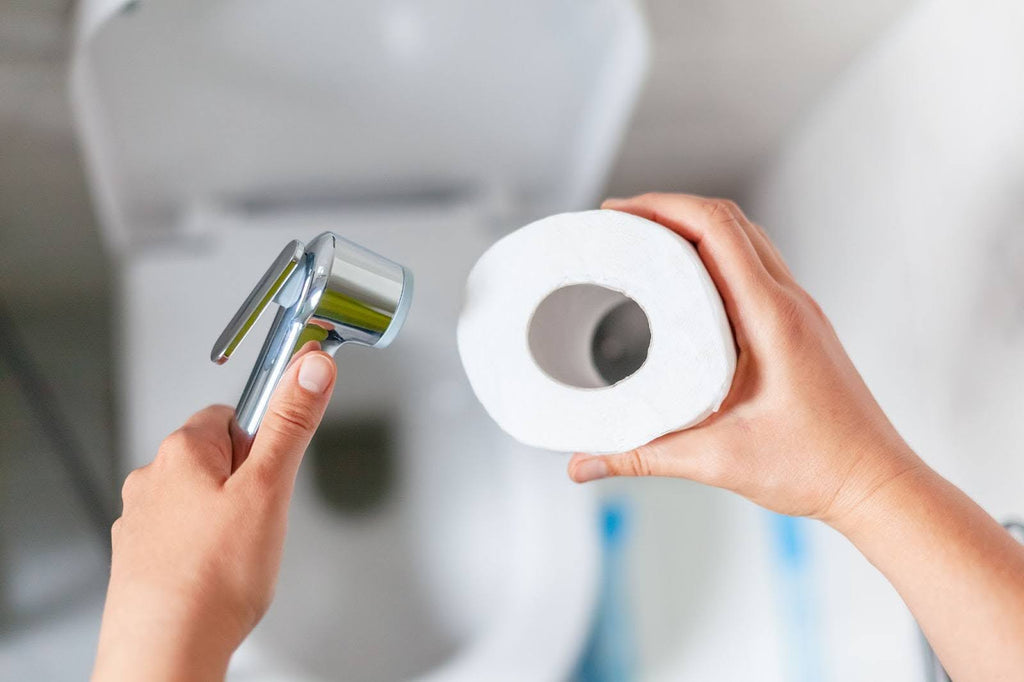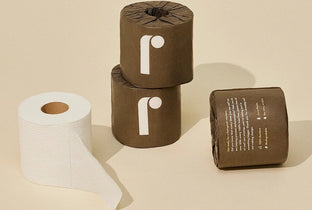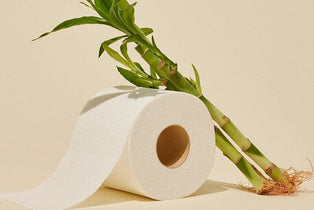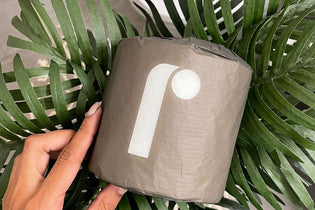
TLDR
In the quest for personal hygiene and environmental sustainability, the debate between using toilet paper and bidets has become increasingly relevant. As we become more conscious of our environmental footprint, it's crucial to examine our daily choices, including how we approach basic hygiene. This discussion is not just about personal preference; it's about understanding the impact of our choices on the planet and our health. And in this context, let's introduce Reel Paper, a company that's redefining the way we think about toilet paper with our sustainable, 100% bamboo toilet paper.
The Reign of Toilet Paper
What is Toilet Paper?
Toilet paper, a staple in most households, has a fascinating history and evolution. So, where does toilet paper come from? From ancient Rome's use of sponges on sticks to the tissue paper we know today, toilet paper has evolved to become an indispensable part of our lives
Originally a luxury item, it has become an essential part of daily hygiene practices across the globe. The convenience and familiarity of toilet paper make it a go-to choice for many. But what exactly is it?
Toilet paper, or toilet tissue, is a soft paper product used to clean the body after defecation or urination. Its evolution from luxury to necessity is a testament to its importance in maintaining personal hygiene. Reel Paper takes this a step further by offering a comfortable alternative to toilet paper, made from sustainable bamboo fibers, ensuring that while we take care of our personal hygiene, we're also caring for the planet.
Pros of Toilet Paper
Now, let's explore the pros of using toilet paper:
- Convenience and Familiarity: There’s comfort in the familiar. Most of us have grown up with toilet paper and understand its mechanics without a second thought.
- Availability and Affordability: Whether in New York or South America, you’re likely to find a roll in a local corner store, or even bulk toilet paper at a wholesaler.
- Versatility and Portability: From recycled toilet paper to wet wipes, the market offers a myriad of options, some even fitting snugly into our pockets.
- Storage: Toilet paper is easy to store and does not require any special conditions. It can be stored at room temperature for long periods of time.
- Disposability: Toilet paper is a disposable product, which means that it does not need to be washed or reused. This can be convenient for people with busy lifestyles or who have difficulty with personal hygiene.
- Softness: Toilet paper is usually soft and comfortable to use. This is especially important for people with sensitive skin or medical conditions such as hemorrhoids.
Cons of Toilet Paper
However, the use of toilet paper is not without its drawbacks, especially when considering the environmental impact. Let’s take a look at the cons:
- Environmental Impact: Traditional toilet paper contributes to deforestation, and its production involves significant water and energy consumption. This is where Reel Paper makes a difference. Our bamboo-based toilet paper offers a sustainable alternative, reducing the environmental impact significantly. Is toilet paper biodegradable? Yes, but the rate at which it decomposes can vary based on its composition and environmental conditions.
- Health Concerns: Continuous wiping can lead to skin irritation and an increase in bacteria. Additionally, for those with conditions like anal fissures, traditional methods might exacerbate the issue [1].
- Financial Cost Over Time: While toilet paper is affordable, the cumulative cost over time can add up, especially when considering the environmental cost of production for traditional toilet paper. That’s why you can feel good about your purchases when you shop at Reel Paper, as our household paper products are created with our planet in mind.
- Comfort: Many cheap types of toilet paper can be rough and uncomfortable to use, especially for people with sensitive skin.
The Rise of Bidets
What is a Bidet?
A bidet, often seen as a luxurious bathroom fixture in many parts of the world, is designed to clean the genital and anal areas after using the toilet. Originating in France in the 17th century, the bidet has evolved significantly. Today, it comes in various forms, including bidet toilet seats, standalone bidets, and bidet attachments that can be added to existing toilets.
Functionality and Usage
Bidets use a stream of water for cleaning, which can be more effective than toilet paper alone. The modern bidet offers a range of features, from temperature control to adjustable water pressure, and even a heated seat for added comfort.
Pros of Bidets
It's important to recognize that bidets represent a significant shift in bathroom hygiene practices, offering a modern, water-based approach to cleanliness. Let’s take a look at their pros:
- Cleanliness and Hygiene: Bidets provide a thorough cleaning, reducing the likelihood of bacteria and infection.
- Environmental Benefits: Using a bidet can significantly reduce the consumption of toilet paper, thus lessening the environmental impact associated with paper production.
- Long-term Financial Savings: Although there's an initial cost for installation, over time, a bidet can be more cost-effective due to reduced need for toilet paper.
- Luxury and Comfort: Features like a heated seat and adjustable settings enhance the user experience, making it a luxurious addition to the bathroom.
Cons of Bidets
However, bidets are not without their drawbacks:
- Initial Cost and Installation: Installing a bidet, especially a standalone bidet or a bidet toilet seat, can be costly and may require professional help.
- Initial Cost and Installation: While many models fit on existing toilets, others might require more extensive bathroom renovations.
- Learning Curve and Adjustment Period: Some people may find the sensation of using a bidet unfamiliar and may need time to adjust.
- Bathroom Modifications: While many models fit on existing toilets, others might require more extensive bathroom renovations, such as installing a new electrical outlet.
- Continual Water Use: Although bidets are touted for their cleanliness, they do require a continuous supply of water. This can lead to increased water usage, which might be a concern in areas with water scarcity or for those trying to reduce their environmental footprint.
- Materials Used: Many bidet attachments are made from non-recycled plastic. This raises environmental concerns, as the production and disposal of these plastics contribute to pollution and are not sustainable in the long term.
Toilet Paper vs Bidet: Comparing the Two
Health Considerations
When it comes to hygiene, bidets offer a more thorough cleaning compared to toilet paper. This can be particularly beneficial for individuals with specific medical conditions or those prone to infections. However, high-quality toilet paper, like that from Reel Paper, can still provide effective cleaning while being gentle on sensitive skin.
Environmental Implications
The environmental impact of traditional toilet paper is significant, involving deforestation and high water and energy consumption [2]. Bidets reduce the need for toilet paper, but their manufacturing and water use also have environmental footprints. Bidet manufacturers claim bidets use about 1/8th of a gallon per use [3]. What they don’t tell you is that that’s the amount of water a bidet uses before flushing.
Reel Paper's bamboo-based toilet paper presents a sustainable alternative, mitigating the environmental concerns associated with traditional toilet paper.
Cost Analysis
Bidets involve an initial investment and may lead to long-term savings by reducing the need for toilet paper.
Ease of Use and Adaptation
Toilet paper is familiar and easy to use, making it a convenient option for most people. Bidets, while offering a range of features, require a period of adaptation. Innovations in bidet features are continually improving user experience, but the simplicity and familiarity of toilet paper remain appealing to many.
Reel’s Sustainable Solution
When you’re not ready to use a bidet, need some time to save money for the purchase and installation of one, or simply find toilet paper easier to use and a more versatile way of cleaning up, you can look to Reel Paper for a cost effective way to go the traditional route.
Revolutionizing the way we think about toilet tissue, Reel offers household paper products like our premium bamboo toilet paper and recycled paper towels. Crafted from bamboo and 100% recycled paper, our products boast a smaller carbon footprint than their traditional counterparts. Plus, with a commitment to plastic-free packaging and carbon neutrality, Reel is at the forefront of eco-friendly bathroom solutions.
To bidet or not to bidet, that is the question. But as the world pivots to more sustainable solutions, whether you're Team Toilet Paper or Team Bidet, the environment should always be a top priority. Dive into our recent posts for more insights on sustainable living, and remember: it's not just about personal cleanliness but planetary cleanliness too.
Sources:
- The American Society of Colon and Rectal Surgeons. 2020. “Pruritis Ani Expanded Version | ASCRS.” Fascrs.org. 2020. https://fascrs.org/patients/diseases-and-conditions/a-z/pruritis-ani-expanded-version.
- The Guardian. 2023. “Flushing Our Forests: The Surprising Connection between Loo Paper and Deforestation.” The Guardian, May 24, 2023. https://www.theguardian.com/who-gives-a-crap-uncrap-the-world/2023/may/25/flushing-our-forests-the-surprising-connection-between-loo-paper-and-deforestation.
- Omigo. 2020. “How Much Water Does a Bidet Use and Is It Warm?” Omigo. August 20, 2020. https://myomigo.com/blogs/news/how-much-water-does-a-bidet-use-and-is-it-warm.



0 comments